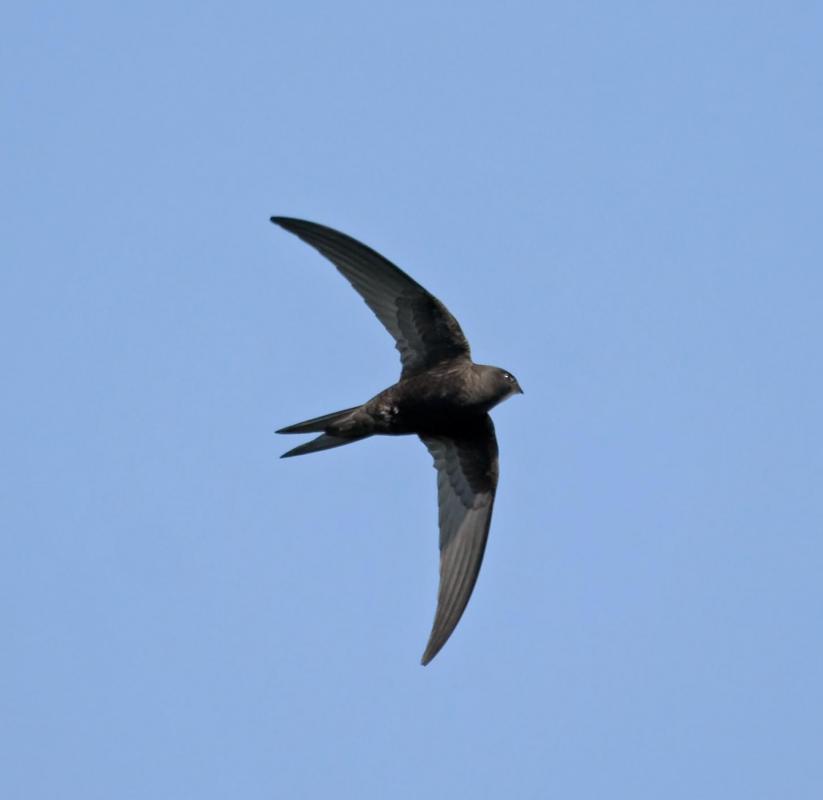At AllThingsNature, we're committed to delivering accurate, trustworthy information. Our expert-authored content is rigorously fact-checked and sourced from credible authorities. Discover how we uphold the highest standards in providing you with reliable knowledge.
What is a Little Swift?
A little swift, or Apus affinis, is a small bird native to Africa and southern Asia. Similar in size and general appearance to a swallow, the little swift is, however, unrelated to that separate family of birds. Like the swallows, little swifts possess short, pointed wings that allow for high maneuverability in the air, where they spend most of their time. They are mostly black, with patches of white on the tail and hindquarters. The tail is short and square, and the bird's wingspan is about 13 inches (33 cm).
Little swifts frequently build their nests on manmade buildings and structures, though they might also nest in the sides of cliffs or in trees and shrubs. They occasionally will take over abandoned swallow nests, modifying them to suit their own needs. The nest of the little swift is bowl-shaped and somewhat disorderly, made of grass and feathers glued together with the bird’s saliva. Nests are almost always seen in colonies, some consisting of as many as 30 nests grouped together. Little swifts return to the same nesting site year after year.

The little swift mates for life and produces batches of one to three white eggs, which the parents take turns incubating. The eggs hatch in about 20-26 days, and the newborn chicks remain in the nest for another 35-40 days, after which they become fully independent. Some populations of little swifts remain in the same area throughout the year, but others are migratory and travel south during the winter.
Often seen in flocks, the little swift spends much of its time at high altitudes, where it does a good deal of its hunting. Common prey includes insects such as termites, mantids, grasshoppers and dragonflies. Although it is a formidable predator of these small creatures, the little swift is in turn preyed upon by several species of falcons as well as at least one type of owl.
The name of the genus to which the Little Swift belongs, Apus, is derived from a Greek word meaning “without feet.” This is because their legs are very short, and they never alight on the ground, preferring to roost vertically on walls or cliffs. They even drink while in flight, swooping down to the water for a sip while flying instead of landing to take a drink. The little swift can be identified by its small size, fluttering style of flight and high chirping voice. Little swifts are sometimes also called house swifts, but the house swift is generally considered to be a separate — though closely related — species with a more easterly range.
Frequently Asked Questions
What is a Little Swift?
A Little Swift, scientifically known as Apus affinis, is a small bird species belonging to the swift family. It is known for its remarkable flying abilities, spending most of its life airborne. These birds are characterized by their dark, sooty brown plumage, a small body size of about 16 centimeters in length, and a wingspan that can reach up to 35 centimeters.
Where can you find Little Swifts?
Little Swifts are widely distributed across sub-Saharan Africa, the Middle East, and parts of Asia. They thrive in a variety of habitats, including open countryside, urban areas, and near water bodies. Their adaptability to different environments allows them to nest in a range of locations, from cliffs to buildings.
What do Little Swifts eat?
Little Swifts are aerial insectivores, meaning they feed on insects caught in flight. Their diet primarily consists of flying ants, beetles, and other small insects. The birds' agile flight patterns and wide gape make them efficient hunters, snatching prey mid-air with precision.
How do Little Swifts nest and reproduce?
Little Swifts are communal nesters, often building their nests in colonies under eaves, cliffs, or inside hollow structures. They use saliva as glue to construct and attach their nests to vertical surfaces. A typical clutch contains two to three eggs, with both parents sharing incubation duties and chick rearing.
Are Little Swifts migratory?
Some populations of Little Swifts are sedentary, while others are partially migratory, depending on the regional climate and food availability. Migratory groups may travel considerable distances, but the species is not known for undertaking long transcontinental migrations like some other swift species.
What conservation status do Little Swifts have?
According to the International Union for Conservation of Nature (IUCN), the Little Swift is currently listed as Least Concern. This status indicates that the species is widespread and abundant, with no immediate threat of significant population decline. However, monitoring is essential to ensure that environmental changes do not negatively impact their numbers.
AS FEATURED ON:
AS FEATURED ON:











Discuss this Article
Post your comments